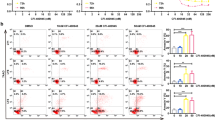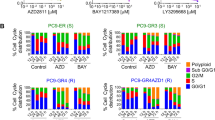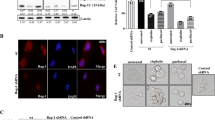Abstract
Breast cancer (BC) is a significant tissue for women’s health worldwide. The spindle assembly checkpoint protein family includes BUBR1 (Bub1-related kinase or MAD3/Bub1b). High expression of BUBR1 promotes cell cycle disorders, leading to cell carcinogenesis and cancer progression. However, the underlying molecular mechanism and the role of BUBR1 in BC progression are unclear. The published dataset was analyzed to evaluate the clinical relevance of BUBR1. BUBR1 was knocked down in BC cells using shRNA. The CCK-8 assay was used to measure the cell viability, and mRNA and protein expression levels were detected by RT-qPCR and Western blot (WB). Cell apoptosis and cell cycle were detected by flow cytometry. Subcutaneous xenograft model was used to assess in vivo tumor growth. BUBR1 was found to be highly expressed in BC. The high expression of BUBR1 was associated with poor prognosis of BC patients. Upon BUBR1 knockdown using shRNA, the proliferation and metastatic ability of cells were decreased. Moreover, the cells with BUBR1 knockdown underwent cell cycle arrest. And the results showed that BUBR1 loss inhibited the phosphorylation of TAK1/JNK. In vitro and in vivo studies indicated the knockdown of BUBR1 rendered the BC cells more sensitive to cisplatin. In summary, BUBR1 may be a potential therapeutic target for BC and targeting BUBR1 may help overcome cisplatin resistance in BC patients.








Similar content being viewed by others
Data availability
The data that support the findings of this study are available from the corresponding author upon reasonable request.
References
Afrashteh Nour M, Hajiasgharzadeh K, Kheradmand F, Asadzadeh Z, Bolandi N, Baradaran B (2021) Nicotinic acetylcholine receptors in chemotherapeutic drugs resistance: an emerging targeting candidate. Life Sci 278:119557
Bukowski K, Kciuk M, Kontek R (2020) Mechanisms of multidrug resistance in cancer chemotherapy. Int J Mol Sci 21(9):3233
Cai Y, Mei J, Xiao Z, Xu B, Jiang X, Zhang Y, Zhu Y (2019) Identification of five hub genes as monitoring biomarkers for breast cancer metastasis in silico. Hereditas 156:20
Dasari S, Njiki S, Mbemi A, Yedjou CG, Tchounwou PB (2022) Pharmacological effects of cisplatin combination with natural products in cancer chemotherapy. Int J Mol Sci. 23(3):1532
Dasari S, Tchounwou PB (2014) Cisplatin in cancer therapy: molecular mechanisms of action. Eur J Pharmacol 740:364–378
Dinić J, Efferth T, García-Sosa AT, Grahovac J, Padrón JM, Pajeva I, Rizzolio F, Saponara S, Spengler G, Tsakovska I (2020) Repurposing old drugs to fight multidrug resistant cancers. Drug Resist Updat 52:100713
Dong C, Tian X, He F, Zhang J, Cui X, He Q, Si P, Shen Y (2021) Integrative analysis of key candidate genes and signaling pathways in ovarian cancer by bioinformatics. J Ovarian Res 14:92
Elowe S, Bolanos-Garcia VM (2022) The spindle checkpoint proteins BUB1 and BUBR1: (SLiM)ming down to the basics. Trends Biochem Sci 47:352–366
Evan GI, Vousden KH (2001) Proliferation, cell cycle and apoptosis in cancer. Nature 411:342–348
Gao X, Leone GW, Wang H (2020) Cyclin D-CDK4/6 functions in cancer. Adv Cancer Res 148:147–169
Goel S, Bergholz JS, Zhao JJ (2022) Targeting CDK4 and CDK6 in cancer. Nat Rev Cancer 22:356–372
He Z, Chen Z, Tan M, Elingarami S, Liu Y, Li T, Deng Y, He N, Li S, Fu J, Li W (2020) A review on methods for diagnosis of breast cancer cells and tissues. Cell Prolif 53:e12822
Hirata Y, Sugie A, Matsuda A, Matsuda S, Koyasu S (2013) TAK1-JNK axis mediates survival signal through Mcl1 stabilization in activated T cells. J Immunol 190:4621–4626
Huang XL, Zhang H, Yang XY, Dong XY, Xie XY, Yin HB, Gou X, Lin Y, He WY (2017) Activation of a c-Jun N-terminal kinase-mediated autophagy pathway attenuates the anticancer activity of gemcitabine in human bladder cancer cells. Anticancer Drugs 28:596–602
Knudsen ES, Kumarasamy V, Nambiar R, Pearson JD, Vail P, Rosenheck H, Wang J, Eng K, Bremner R, Schramek D, Rubin SM, Welm AL, Witkiewicz AK (2022) CDK/cyclin dependencies define extreme cancer cell-cycle heterogeneity and collateral vulnerabilities. Cell Rep 38:110448
Komura K, Inamoto T, Tsujino T, Matsui Y, Konuma T, Nishimura K, Uchimoto T, Tsutsumi T, Matsunaga T, Maenosono R, Yoshikawa Y, Taniguchi K, Tanaka T, Uehara H, Hirata K, Hirano H, Nomi H, Hirose Y, Ono F, Azuma H (2021) Increased BUB1B/BUBR1 expression contributes to aberrant DNA repair activity leading to resistance to DNA-damaging agents. Oncogene 40:6210–6222
Lai W, Zhu W, Xiao C, Li X, Wang Y, Han Y, Zheng J, Li Y, Li M, Wen X (2021) HJURP promotes proliferation in prostate cancer cells through increasing CDKN1A degradation via the GSK3β/JNK signaling pathway. Cell Death Dis 12:583
Latham SL, O’Donnell YEI, Croucher DR (2022) Non-kinase targeting of oncogenic c-Jun N-terminal kinase (JNK) signaling: the future of clinically viable cancer treatments. Biochem Soc Trans 50:1823–1836
Li CL, Liu B, Wang ZY, Xie F, Qiao W, Cheng J, Kuang JY, Wang Y, Zhang MX, Liu DS (2020) Salvianolic acid B improves myocardial function in diabetic cardiomyopathy by suppressing IGFBP3. J Mol Cell Cardiol 139:98–112
Lugones Y, Loren P, Salazar LA (2022) Cisplatin resistance: genetic and epigenetic factors involved. Biomolecules 12(10):1365
Makovec T (2019) Cisplatin and beyond: molecular mechanisms of action and drug resistance development in cancer chemotherapy. Radiol Oncol 53:148–158
Mukhopadhyay H, Lee NY (2020) Multifaceted roles of TAK1 signaling in cancer. Oncogene 39:1402–1413
Ni Z, Sun P, Zheng J, Wu M, Yang C, Cheng M, Yin M, Cui C, Wang G, Yuan L, Gao Q, Li Y (2022) JNK signaling promotes bladder cancer immune escape by regulating METTL3-mediated m6A modification of PD-L1 mRNA. Cancer Res 82:1789–1802
Palmer N, Kaldis P (2020) Less-well known functions of cyclin/CDK complexes. Semin Cell Dev Biol 107:54–62
Qiu J, Zhang S, Wang P, Wang H, Sha B, Peng H, Ju Z, Rao J, Lu L (2020) BUB1B promotes hepatocellular carcinoma progression via activation of the mTORC1 signaling pathway. Cancer Med 9:8159–8172
Qiu Z, Oleinick NL, Zhang J (2018) ATR/CHK1 inhibitors and cancer therapy. Radiother Oncol 126:450–464
Riggio AI, Varley KE, Welm AL (2021) The lingering mysteries of metastatic recurrence in breast cancer. Br J Cancer 124:13–26
Safa AR (2020) Resistance to drugs and cell death in cancer stem cells (CSCs). J Transl Sci 6(3):341
Smith J, Tho LM, Xu N, Gillespie DA (2010) The ATM-Chk2 and ATR-Chk1 pathways in DNA damage signaling and cancer. Adv Cancer Res 108:73–112
Song M, Cui M, Liu K (2022) Therapeutic strategies to overcome cisplatin resistance in ovarian cancer. Eur J Med Chem 232:114205
Strzyz P (2016) Cell signalling: signalling to cell cycle arrest. Nat Rev Mol Cell Biol 17:536
Su W, Gao W, Zhang R, Wang Q, Li L, Bu Q, Xu Z, Liu Z, Wang M, Zhu Y, Wu G, Zhou H, Wang X, Lu L (2023) TAK1 deficiency promotes liver injury and tumorigenesis via ferroptosis and macrophage cGAS-STING signalling. JHEP Rep 5:100695
Suijkerbuijk SJ, van Osch MH, Bos FL, Hanks S, Rahman N, Kops GJ (2010) Molecular causes for BUBR1 dysfunction in the human cancer predisposition syndrome mosaic variegated aneuploidy. Cancer Res 70:4891–4900
Suski JM, Braun M, Strmiska V, Sicinski P (2021) Targeting cell-cycle machinery in cancer. Cancer Cell 39:759–778
Weaver RL, Limzerwala JF, Naylor RM, Jeganathan KB, Baker DJ, van Deursen JM (2016) BubR1 alterations that reinforce mitotic surveillance act against aneuploidy and cancer. Elife 5:e16620
Xu G, Niu L, Wang Y, Yang G, Zhu X, Yao Y, Zhao G, Wang S, Li H (2022) HDAC6-dependent deacetylation of TAK1 enhances sIL-6R release to promote macrophage M2 polarization in colon cancer. Cell Death Dis 13:888
Yang Z, Liu D, Zhou H, Tao B, Chang L, Liu H, Luo H, Wang D, Liu W (2021) A new nanomaterial based on extracellular vesicles containing chrysin-induced cell apoptosis through Let-7a in tongue squamous cell carcinoma. Front Bioeng Biotechnol 9:766380
Zhang C, Xu C, Gao X, Yao Q (2022) Platinum-based drugs for cancer therapy and anti-tumor strategies. Theranostics 12:2115–2132
Zhou X, Yuan Y, Kuang H, Tang B, Zhang H, Zhang M (2022) BUB1B (BUB1 mitotic checkpoint serine/threonine kinase B) promotes lung adenocarcinoma by interacting with Zinc Finger Protein ZNF143 and regulating glycolysis. Bioengineered 13:2471–2485
Zou Y, Zheng Q, Jiang B, Liu Y, Xu Y, Ma L, Hu Z, Wu M, Song H (2022) Deficiency of PPP6C protects TNF-induced necroptosis through activation of TAK1. Cell Death Dis 13:618
Acknowledgements
The authors would like to thank all the reviewers who participated in the paper, as well as MJEditor (www.mjeditor.com) for providing English editing services during the preparation of this manuscript.
Funding
This study was supported by National Key Research and Development (R&D) Program of China (No. 2022YFF0710503, to Y.D.), Jilin Scientific and Technological Development Program (No. 20230505037ZP, to Y.D.), and Natural Science Foundation of Jilin Province (No. 20210101364JC, to Y.D.).
Author information
Authors and Affiliations
Contributions
Conceptualization, Yu Ding and Yiran Lu; methodology, RuiQing Wang; software, Song He; validation, Song He and Qing Zhang; formal analysis, Yiran Lu; investigation, Yu Ding; resources, Yu Ding; data curation, Yiran Lu; writing—original draft preparation, Yu Ding and Yiran Lu; writing—review and editing, Yu Ding, Yiran Lu and Song He; visualization, Jiahui Wei; supervision, Jiahui Wei and Jinping Hu; project administration, Yu Ding and Ruiqing Wang; funding acquisition, Yu Ding and Jinping Hu. All the authors have read and agreed to the published version of the manuscript.
Corresponding author
Ethics declarations
Ethics approval
The study was conducted in accordance with the Declaration of Helsinki, and approved by the Medical Ethics Committee of Jilin University Second Hospital (April 6, 2023) for studies involving humans. The animal study protocol was approved by the Experimental Animal Welfare Ethics Committee of Jilin University (Approval number: SY202207300, July 8, 2022) for studies involving animals.
Informed consent
Informed consent was obtained from all subjects involved in the study. Written informed consent has been obtained from the patient(s) to publish this paper.
Conflict of interest
The authors declare no competing interests.
Supplementary Information
Below is the link to the electronic supplementary material.
Rights and permissions
Springer Nature or its licensor (e.g. a society or other partner) holds exclusive rights to this article under a publishing agreement with the author(s) or other rightsholder(s); author self-archiving of the accepted manuscript version of this article is solely governed by the terms of such publishing agreement and applicable law.
About this article
Cite this article
Lu, Y., Wang, R., He, S. et al. Downregulation of BUBR1 regulates the proliferation and cell cycle of breast cancer cells and increases the sensitivity of cells to cisplatin. In Vitro Cell.Dev.Biol.-Animal 59, 778–789 (2023). https://doi.org/10.1007/s11626-023-00823-w
Received:
Accepted:
Published:
Issue Date:
DOI: https://doi.org/10.1007/s11626-023-00823-w




